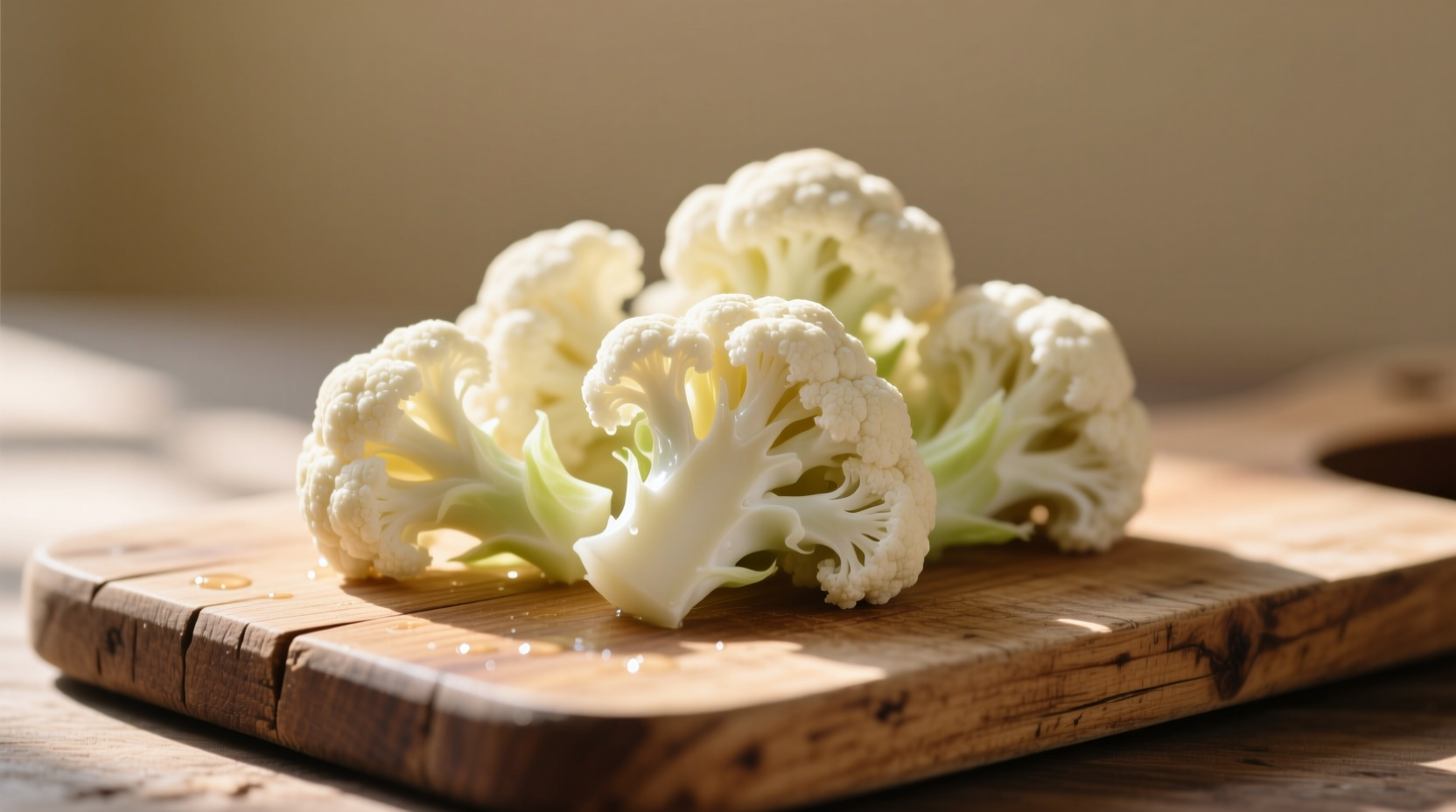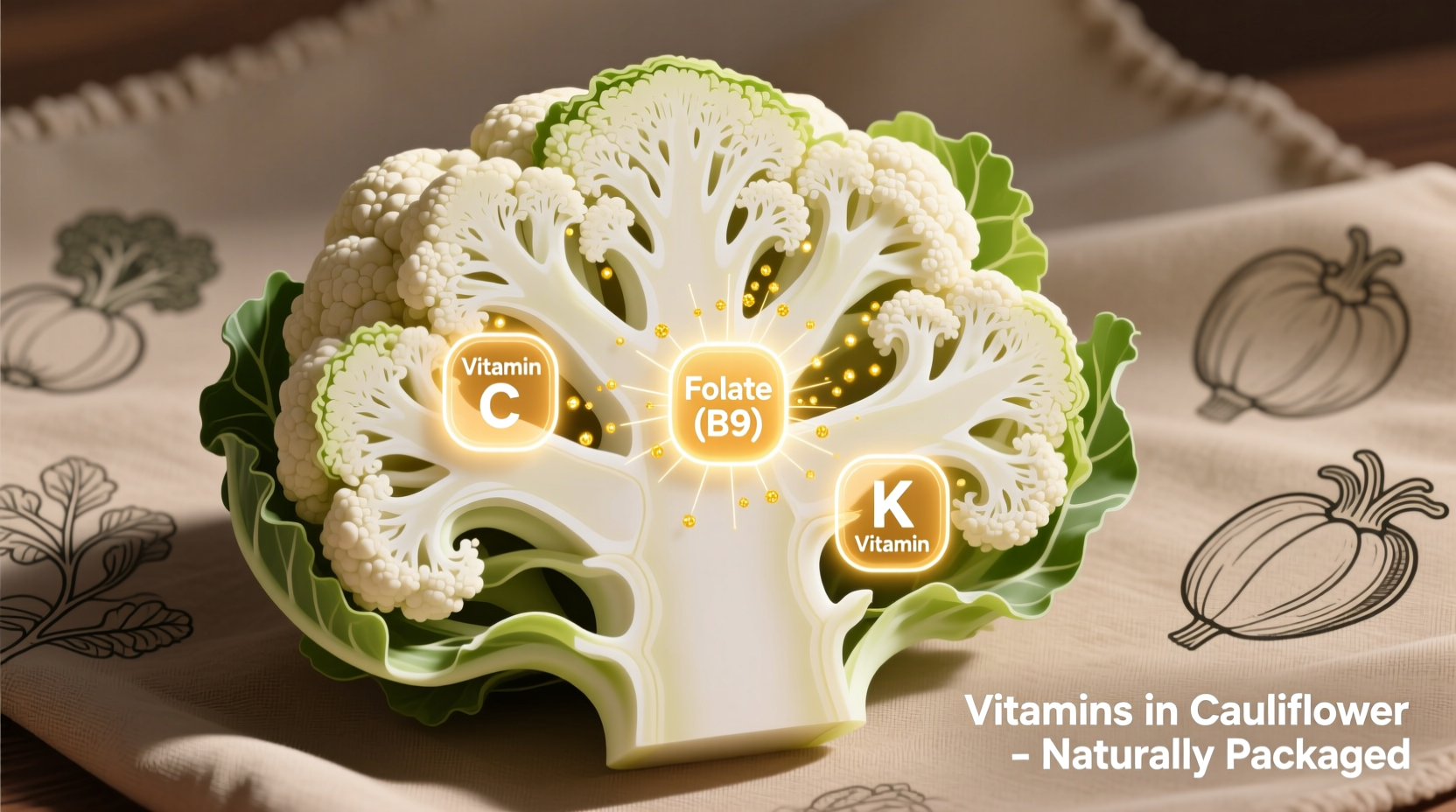Why Cauliflower Deserves a Spot on Your Plate
Often overshadowed by flashier superfoods, cauliflower quietly delivers exceptional nutritional value. This cruciferous vegetable isn't just a low-carb substitute—it's a vitamin powerhouse that provides substantial daily requirements of several essential nutrients. Understanding exactly what vitamins cauliflower contains and how they benefit your body can help you make smarter dietary choices.
Vitamin Profile: What's Inside One Cup of Cauliflower
According to the USDA FoodData Central database, a single cup (100g) of raw cauliflower contains these key vitamins:
| Vitamin | Amount per Cup | % Daily Value | Primary Health Benefits |
|---|---|---|---|
| Vitamin C | 48.2 mg | 77% | Immune support, collagen production, antioxidant protection |
| Vitamin K | 15.5 μg | 20% | Blood clotting, bone metabolism, cardiovascular health |
| Vitamin B6 | 0.18 mg | 11% | Brain development, neurotransmitter production, metabolism |
| Folate (B9) | 57 μg | 14% | Cell division, DNA synthesis, fetal development |
| Choline | 14.3 mg | 3% | Brain health, liver function, cell membrane integrity |
Vitamin C: Cauliflower's Star Nutrient
With 48.2mg of vitamin C per cup—more than 75% of your daily requirement—cauliflower outperforms many fruits in this category. This potent antioxidant plays multiple critical roles in your body:
- Strengthens immune function by supporting white blood cell production
- Facilitates collagen synthesis for healthy skin, bones, and connective tissues
- Enhances iron absorption from plant-based foods
- Protects cells from free radical damage that contributes to chronic disease
Unlike many fruits, cauliflower delivers this vitamin C without significant sugar content, making it an excellent choice for those monitoring carbohydrate intake.
How Cauliflower Compares to Other Vegetables
While broccoli often steals the spotlight in the cruciferous family, cauliflower holds its own in the vitamin department. Research from the National Institutes of Health shows that raw cauliflower contains comparable vitamin C to raw broccoli (48.2mg vs 45.6mg per 100g), though broccoli provides more vitamin K and folate.
When compared to other common vegetables:
- Contains more vitamin C than cooked spinach (which loses significant vitamin C during cooking)
- Provides similar folate levels to green peas but with fewer calories
- Offers more vitamin K than cucumbers or zucchini, though less than leafy greens
Cooking Methods That Preserve Maximum Vitamins
How you prepare cauliflower significantly impacts its vitamin retention. Studies published in the Journal of Food Science demonstrate that water-soluble vitamins like C and B vitamins are particularly vulnerable to heat and water exposure.
For optimal vitamin preservation:
- Steaming retains up to 90% of vitamin C compared to boiling which can leach out 50% or more
- Raw consumption preserves all heat-sensitive vitamins but may cause digestive discomfort for some
- Roasting at moderate temperatures (375°F/190°C) preserves most nutrients while enhancing flavor
- Avoid prolonged boiling which causes significant vitamin loss into cooking water

Practical Ways to Boost Your Vitamin Intake
Incorporating more cauliflower into your diet doesn't require complicated recipes. These simple strategies maximize vitamin absorption:
- Add raw cauliflower florets to salads with lemon-tahini dressing (the vitamin C enhances iron absorption from other ingredients)
- Blend steamed cauliflower into soups for added creaminess without dairy
- Pair roasted cauliflower with vitamin E-rich foods like avocado or olive oil to improve fat-soluble vitamin absorption
- Include cauliflower in stir-fries with minimal cooking time to preserve water-soluble vitamins
Who Benefits Most from Cauliflower's Vitamin Profile
Certain populations particularly benefit from regular cauliflower consumption:
- Pregnant women need adequate folate for fetal development (one cup provides 14% of daily needs)
- Individuals with limited sun exposure can support bone health through cauliflower's vitamin K content
- Those managing blood sugar benefit from the low-glycemic vitamin delivery system
- People reducing meat consumption gain choline and other nutrients typically associated with animal products
According to dietary guidelines from the USDA, adults should aim for 1.5-2 cups of dark green vegetables per week, which includes cruciferous vegetables like cauliflower. Meeting this recommendation supports overall nutrient adequacy.
Maximizing Your Cauliflower Experience
To get the most from cauliflower's vitamin content, select heads with tight, creamy-white florets and bright green leaves. Store whole heads in a perforated plastic bag in your refrigerator's crisper drawer for up to two weeks. For best nutrient retention, wash just before use and minimize pre-cutting time before cooking.
Remember that variety remains key—while cauliflower offers impressive vitamin content, rotating it with other colorful vegetables ensures you receive the full spectrum of phytonutrients and vitamins your body needs.











 浙公网安备
33010002000092号
浙公网安备
33010002000092号 浙B2-20120091-4
浙B2-20120091-4